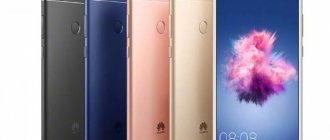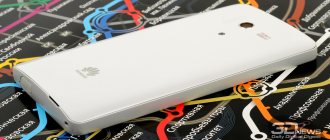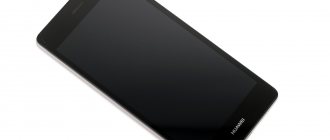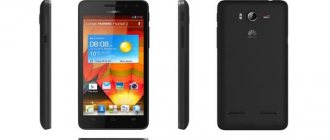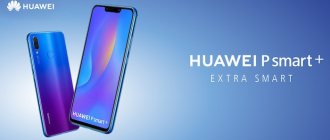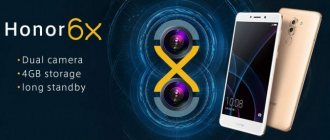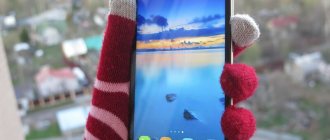In May 2021, Huawei introduced its new mobile phone - budget, but equipped with a number of modern technologies, Huawei Y8p. But in contrast to this is the lack of Google services due to US sanctions. As an alternative to them, the Chinese manufacturer offers its services, which we will mention in our review of the Huawei Y8p 4 128gb smartphone. In it you will find all the pros, cons, example photos, find out the battery life in different usage scenarios, and also get acquainted with the characteristics.
Case design and dimensions
The 6.3-inch display occupies 83% of the front panel, there are frames and by modern standards they are quite thick. For the same money there are many solutions where they will be smaller, but the moment is not critical. At the top there is a small teardrop-shaped cutout where the selfie camera was built in.
The glass back has a glossy finish that quickly gets dirty and becomes covered in fingerprints. But there is one trick - the light gradient design in the blue version (eating crystal) makes it more practical, the prints are almost invisible. This cannot be said about the black version (midnight black). Other colors include blue and emerald green.
The unit with the main camera turned out to be especially successful. It is made carefully, and not as often happens in 2021, when the manufacturer strives to cram as many cameras as possible into a minimal space. Three lenses are mounted vertically. If you look closely, there is no fingerprint scanner anywhere. The thing is that even in state-priced ones they have already learned to build it under the screen. The decision is questionable, but we will talk about this below.
The Huawei Y8p review in Russian moves on to the location of the keys and functional elements. Everything is standard - on the right side there is a power button and a volume rocker.
The space on the left is allocated for a hybrid tray, where you can install two SIM cards or one, but paired with MicroSD.
At the bottom there is a USB Type-C port and a multimedia speaker.
On top is a 3.5 mm audio jack, which is practically no longer used in modern phones, which means its presence can be regarded as an advantage. There is also a microphone here.
The case dimensions are small - 157.4x73.2x7.8 mm with a weight of 163 grams. This, combined with the rounded edges, makes it easy to operate with one hand. The side frame running along the entire perimeter is made of plastic. Not a very pleasant moment; many competitors have metal ones. The screen of the Huawei Y8p phone has an oleophobic coating applied. The finger glides well and leaves no fingerprints. The case is not slippery, but a case would be a good idea if you want to maintain its attractiveness over many years of use.
Display
The fingerprint sensor is built into the screen - this is a progressive solution, but in terms of response speed it is still inferior to the traditional one. The review showed that Huawei Y8p has no problems with recognition accuracy - out of 100 attempts, 99 were successful. The recognition speed exceeds the initial solutions when the technology appeared on the market, but it is still far from perfect.
The screen characteristics are impressive - with a diagonal of 6.3 inches, it operates at a resolution of 2400x1080, which gives a pixel density of 418 ppi. But the main thing is the OLED matrix, which is not what you expect from the budget segment. Thanks to this, we get deep black color and the ability to flexibly adjust brightness - from close to natural to oversaturated shades.
The Y8p's display is several levels above its competitors in price. The image on it looks bright and saturated, it is not distorted when the viewing angle changes. The brightness margin is sufficient to maintain readability of the text when exposed to direct sunlight.
⇡#Technical characteristics
| Huawei Nova 8 | Huawei nova 5T | vivo V21 | OnePlus 9 | Huawei P40 | |
| Display | 6.57 inches, OLED, 2340 × 1080 pixels, 392 ppi, capacitive multi-touch | 6.26 inches, IPS, 2340 × 1080 pixels, 412 ppi, capacitive multi-touch | 6.44 inches, AMOLED, 2400 × 1080 pixels, 409 ppi, capacitive multi-touch | 6.55 inches, Fluid AMOLED, 2400 × 1080 pixels, 402 ppi, capacitive multi-touch, 120 Hz | 6.1 inches, OLED, 2340 × 1080 pixels, 422 ppi, capacitive multi-touch |
| Protective glass | No information | No information | No information | Corning Gorilla Glass 5 | No information |
| CPU | HiSilicon Kirin 820E: six cores (3 × ARM Cortex A76, frequency 2.22 GHz + 3 × ARM Cortex A55, frequency 1.84 GHz); HiAI architecture | HiSilicon Kirin 980: eight cores (2 × ARM Cortex A76, 2.6 GHz frequency + 2 × ARM Cortex A76, 1.92 GHz frequency + 4 × ARM Cortex A55, 1.8 GHz frequency); HiAI architecture | MediaTek MT6853 Dimensity 800U 5G: Eight cores (2 × ARM Cortex-A76 @ 2.4 GHz & 6 × ARM Cortex-A55 @ 2.0 GHz) | Qualcomm Snapdragon 888: one Kryo 680 core at 2.84 GHz, three Kryo 680 cores at 2.42 GHz, four Kryo 680 cores at 1.8 GHz | HiSilicon Kirin 990 5G: eight cores (2 × ARM Cortex-A76, frequency 2.86 GHz + 2 × ARM Cortex-A76, frequency 2.36 GHz + 4 × ARM Cortex-A55, frequency 1.95 GHz); HiAI architecture; 5G modem |
| Graphics controller | ARM Mali-G57 | ARM Mali-G76 MP10, 720 MHz | ARM Mali-G57 MC3 | Adreno 660 | ARM Mali-G76 MP16 |
| RAM | 8 GB | 6/8 GB | 8 GB | 8/12 GB | 6/8 GB |
| Flash memory | 128/256 GB | 128 GB | 128/256 GB | 128/256 GB | 128/256 GB |
| Memory card support | No | No | Yes (separate slot for microSD) | No | Yes (NM only) |
| Connectors | USB Type-C | USB Type-C | USB Type-C | USB Type-C | USB Type-C |
| SIM cards | Two nano-SIMs | Two nano-SIMs | Two nano-SIMs | Two nano-SIMs | Two nano-SIMs |
| Cellular connection 2G | GSM 850/900/1800/1900 MHz CDMA 800 | GSM 850/900/1800/1900 MHz | GSM 850/900/1800/1900 MHz | GSM 850/900/1800/1900 MHz CDMA 800/1900 | GSM 850/900/1800/1900 MHz |
| Cellular 3G | HSDPA 800 / 850 / 900 / 1700 / 1900 / 2100 MHz | HSDPA 800 / 850 / 900 / 1700 / 1900 / 2100 MHz | HSDPA 850 / 900 / 1700 / 1900 / 2100 | HSDPA 800 / 850 / 900 / 1700 / 1800 / 1900 / 2100 MHz | HSDPA 800 / 850 / 900 / 1700 / 1900 / 2100 MHz |
| Cellular 4G | LTE: bands 1, 2, 3, 4, 5, 6, 8, 9, 18, 19, 26, 34, 38, 39, 40, 41 | LTE: bands 1, 3, 4, 5, 7, 8, 18, 19, 20, 26, 28, 38, 40, 41 | LTE: bands 1, 3, 5, 7, 8, 20, 28, 38, 39, 40, 41 | LTE Cat.20 (2000/200 Mbps): bands 1, 2, 3, 4, 5, 7, 8, 12, 13, 17, 18, 19, 20, 25, 26, 28, 32, 38, 39, 40, 41, 66 (European version) | LTE: bands 1, 2, 3, 4, 5, 6, 7, 8, 9, 12, 17, 18, 19, 20, 26, 28, 32, 34, 38, 39, 40, 41 |
| 5G Cellular | SA/NSA: 1, 3, 28, 38, 41, 77, 78, 80, 83, 84 | No | No | SA/NSA: 1, 3, 5, 7, 8, 20, 28, 38, 40, 41, 66, 78 (European version) | SA/NSA: 1, 3, 28, 38, 41, 77, 78, 79 |
| WiFi | 802.11a/b/g/n/ac | 802.11a/b/g/n/ac | 802.11a/b/g/n/ac | 802.11a/b/g/n/ac/6 | 802.11a/b/g/n/ac/6 |
| Bluetooth | 5.1 | 5.0 | 5.1 | 5.2 | 5.1 |
| NFC | Eat | Eat | Eat | Eat | Eat |
| Navigation | GPS, A-GPS, GLONASS, BeiDou, Galileo, QZSS | GPS (dual band), A-GPS, GLONASS, BeiDou, Galileo, QZSS | GPS, A-GPS, GLONASS, BeiDou, Galileo | GPS, A-GPS, GLONASS, BeiDou, Galileo, SBAS | GPS (dual band), A-GPS, GLONASS, BeiDou, Galileo, QZSS, NavIC |
| Sensors | Light, proximity, accelerometer/gyroscope, magnetometer (digital compass), IR sensor | Light, proximity, accelerometer/gyroscope, magnetometer (digital compass), IR sensor | Illumination, proximity, accelerometer/gyroscope, magnetometer (digital compass) | Illumination, proximity, accelerometer/gyroscope, magnetometer (digital compass), color spectrum | Light, proximity, accelerometer/gyroscope, magnetometer (digital compass), Face ID |
| Fingerprint's scanner | Yes, on the screen | Yes, on the side | Yes, on the screen | Yes, on the screen | Yes, on the screen |
| Main camera | Quadruple module: 64 + 8 + 2 + 2 MP, ƒ/1.9 + ƒ/2.4 + ƒ/2.4 + ƒ/2.4, phase detection autofocus with main camera, single LED flash | Quadruple module: 40 + 16 + 16 + 2 MP, ƒ/1.8 + ƒ/2.2 + ƒ/2.4 + ƒ/2.4, phase detection autofocus, LED flash | Triple module, 64 + 8 + 2 MP, ƒ/1.8 + ƒ/2.2 + ƒ/2.4, phase detection autofocus with the main module, optical stabilizer with the main camera, single LED flash | Triple module: 48 MP, ƒ/1.8 + 50 MP, ƒ/2.2 + 2 MP, ƒ/2.4, phase detection autofocus with main and wide-angle cameras, LED flash | Triple module, 50 + 8 + 16 MP, ƒ/1.9 + ƒ/2.4 + ƒ/2.2, phase detection autofocus, optical stabilizer, dual LED flash |
| Front-camera | 32 MP, ƒ/2.0, fixed focus, no flash | 32 MP, ƒ/2.0, fixed focus, no flash | 44 MP, ƒ/2.0, with autofocus, without flash, optical stabilizer | 16 MP, ƒ/2.4, fixed focus, no flash | Dual module: 32 MP, ƒ/2.2 + TOF camera, fixed focus, no flash |
| Nutrition | Non-removable battery: 14.44 Wh (3800 mAh, 3.8 V) | Non-removable battery: 14.25 Wh (3750 mAh, 3.8 V) | Non-removable battery: 15.2 Wh (4000 mAh, 3.8 V) | Non-removable battery: 17.1 Wh (4500 mAh, 3.8 V) | Non-removable battery: 14.44 Wh (3800 mAh, 3.8 V) |
| Size | 160.1 × 74.1 × 7.6 mm | 154.3 × 74 × 7.9 mm | 159.7 × 73.9 × 7.3 mm | 160 × 74.2 × 8.7 mm | 148.9 × 71.1 × 8.5 mm |
| Weight | 169 grams | 174 grams | 176 grams | 192 grams | 175 grams |
| Housing protection | No | No | No | IP68 | IP53 |
| operating system | Android 10, EMUI 12 shell | Android 9.1 Pie, EMUI shell | Android 11, Funtouch OS 11 shell | Android 11, Oxygen UI 11 shell | Android 10, EMUI 10 shell |
| Current price | 39,999 rubles | 24,125 rubles | 38,800 rubles | 39,490 rubles for the 8/128 GB version, 44,360 rubles for the 12/256 GB version | 41,000 rubles |
Huawei Y8p smartphone camera review - when three sensors are enough
The hero of our review impresses with its photographic capabilities. There are three cameras at the back, including a 48 MP main lens, an 8 MP ultra-wide-angle lens and a 2 MP depth sensor. The latter is present more as a marketing ploy; it has virtually no effect on the quality of the photo. The f/1.8 aperture makes the main sensor dependent on lighting.
More interesting on the topic:
|
In good conditions, the Huawei Y8p camera pleases with the detail and color rendition of the photo. But there is a drop in sharpness at the edges of the frame, and the dynamic range is inferior in comparison with top-end camera phones of 2021, but for the price the result is very decent.
There is a night mode, but it doesn’t improve the situation much. Photos are produced with a lot of noise, questionable sharpness and color rendition. If low-light performance is important to you, this is not your choice.
The Huawei Y8p camera is assisted by an artificial intelligence system that, when shooting at night, improves image quality due to multi-frame exposure. User reviews are very contradictory. Daytime shooting suits everyone, but at night, many note an abundance of digital noise. It’s better to evaluate the result in person using the example photos below.
The wide-angle lens is good, but nothing special. The photo quality on it can be described as average. At some points there is a lack of detail and colors are not believable. I am glad that there is no distortion at the edges.
For its budget, the camera of the Huawei Y8p 4 128GB smartphone is good; it will allow you to get a detailed and rich frame.
How are things going with the sound?
The conversational speaker allows you to clearly hear your interlocutor, even when you are on a busy street. The external speaker produces loud and clear sound, but lacks volume. There is no bass at all. High frequencies are distorted if the volume is set above 70%. It is suitable for playing voice messages and watching movies, but listening to music is not very pleasant. For this budget the situation is normal.
Huawei Histen feature allows you to customize the sound to suit your preferences. Pairing with wireless headphones pleased me - there is no delay, the connection is stable.
⇡#Display and sound
Huawei nova 8 has a 6.57-inch diagonal OLED display with a resolution of 2340 × 1080 pixels (format – 19.5:9; it’s even unusual, everyone is making smartphones even narrower and elongated). Pixel density is normal, 392 ppi. There won't be any crazy sharpness, but the detailing is more than acceptable.
The screen supports a refresh rate of 90 Hz - without this, a modern smartphone of a more or less high level simply does not enter the market now.
The measured maximum brightness level is 526 cd/m2 - a very good indicator for an organic LED screen; it is pleasant to use the smartphone in any lighting, including on a sunny day.
In the screen settings, you can turn on eye protection (mode with the warmest colors) and adjust the resolution (HD or Full HD) or font size, and change the color rendering - choose between two profiles (“normal” and “bright”) or set the desired one you color temperature. I measured color rendering in two preset profiles, without individual temperature adjustment.
Huawei nova 8, gamma in bright color mode. Yellow line – nova 8 indicators, dotted line – reference gamma
Huawei nova 8, color temperature in vivid color mode. Blue line – nova 8 indicators, dotted line – reference temperature
Huawei nova 8, color gamut in vivid color mode. Gray triangle – DCI-P3 coverage, white triangle – nova 8 coverage
By default, the Huawei nova 5T screen operates in “bright” mode. The color range in this mode is expanded and close in area to the DCI-P3 standard, but with a shift. The average gamma level is within normal limits (2.22), and with smooth curves (pardon the pun). The color temperature graph is also very smooth and increased slightly - it remains at the level of 7,000 K. The average deviation for the expanded Color Checker palette (shades of gray + a wide range of color shades) is 4.77, with the upper limit of the norm being 3.00. The colors are moderately cool, bright, but not too fair, although the deviation cannot be called critical; after all, we are talking about a smartphone, and not a professional monitor.
Huawei nova 8, gamma in normal color mode. Yellow line – nova 8 indicators, dotted line – reference gamma
Huawei nova 8, color temperature in normal color mode. Blue line – nova 8 indicators, dotted line – reference temperature
Huawei nova 8, color gamut in normal color mode. Gray triangle – sRGB coverage, white triangle – nova 8 coverage
In normal color mode, the color space is narrowed to sRGB, with exactly the same offset relative to the norm as with the bright preset. Gamma is essentially the same - 2.19. The color temperature curve is ideal - it follows the reference value of 6,500 K. But the average DeltaE deviation in the Color Checker palette is worse than in the bright mode - 5.66. It's better not to leave the default color mode - it's better in every way.
Huawei nova 8 lacks an analog audio jack - after all, Huawei Freebuds will not buy themselves, the presence of important TWS headphones in the assortment literally provokes a jack. Via Bluetooth, the main profiles of high-quality data transfer are not supported - neither LDAC, nor aptX; The headphones are connected either using the AAC or SBS profile, which, among other things, affects the power - in the subway you have to turn the volume up to maximum even with noise-canceling headphones. The external speaker is monophonic, located on the lower edge - it is quite loud, but with average sound quality.
Performance - don't expect miracles, but Huawei Y8P copes with games
Let's start our review of Huawei Y8p's characteristics with the processor - Kirin 710F, released in 2021. It is already quite outdated, but is in demand in its segment. It is helped by 4/128 GB of memory. This will be enough for most users, but if not, you can install MicroSD up to 256 Gb. But not everything is so simple, because in this case you will have to give up the second SIM card.
The test in Antutu gave a result of 170,000 points. The hardware is powerful enough for basic functions. The interface works quickly and does not slow down. You can play everything, but on low or medium graphics.
Out of the box, the Huawei Y8p phone runs on Android 10 with EMUI 10.1 overlaid on top. Google and Google Play services are missing; instead, Huawei offers its own alternative. All the necessary software can be installed using the Huawei App Gallery application. Everything else can be downloaded from the Internet.
Contactless payment in Huawei Y8p works if you install the Pay Wallet application
.
⇡#Hardware and performance
Huawei nova 8 is based on the HiSilicon Kirin 820E mid-level hardware platform.
The chip contains six computing cores: three ARM Cortex-A76 cores with a frequency of 2.22 GHz and three ARM Cortex-A55 cores with a clock frequency of 1.84 GHz. Graphics subsystem – ARM Mali-G57. Technological process – 7 nm.
Unfortunately, as has become the norm lately, Huawei is releasing devices for testing with the installation of the main benchmarks blocked - both those that are not officially supported by the ecosystem, like Geekbench and GFXBench, and those that are quite accessible in the AppGallery, like AnTuTu. So we were able to test the smartphone only using, for some reason, supported 3D Mark and browser tests: Sunspider, Webxprt and Octane. In principle, this is enough to understand the level of performance - it allows you to run any modern games on nova 8 without any problems (more precisely, those that will work on a smartphone without Google services), and almost always with high graphic settings. But the Nova will not be able to compete, for example, with the similarly priced Huawei P40 or, especially, the realme GT Nova. First of all, this concerns the reserve for the future - right now, productivity seems sufficient, everything works quickly, but not rapidly.
But Huawei nova 8 has no problems with cooling. Lifetime tests from the 3D Mark package showed virtually no throttling, and the body heats up quite moderately. And our standard CPU Throttling Test also did not work on nova 8.
Huawei nova 8 exists with two options for built-in memory, but is supplied to Russia with only one - 128 GB. Considering the lack of a memory card slot, it’s not too impressive. There is more than enough RAM - 8 GB.
Powerful battery with fast charging
The Huawei Y8p smartphone is equipped with a built-in 4000 mAh battery.
Combined with good optimization, it lasts for
1.5-2 days of active use
.
The average screen activity time is 6 hours
.
In video playback mode, the battery lasted 16 hours
at maximum brightness.
In games it lasted for 5.5 hours
.
The result is more than worthy. Neither fast nor wireless charging are supported. The kit includes a 10-Watt unit
, from which:
- 28%
runs in 30 minutes; - Charging from 0 to 100% takes 2.5 hours.
By modern standards, this is a very long time, even in its segment, where many models support fast charging.
⇡#Communications and wireless communications
Huawei nova 8 has a dual nano-SIM slot. The manufacturer does not indicate the speed of the LTE modem, but everything works quickly, without problems. All required ranges are supported.
Huawei nova 8, slot for two nano-SIM cards
The rest of the wireless connections are in order: there is dual-band Wi-Fi (802.11a/b/g/n/ac, works well), Bluetooth 5.1, NFC, as well as a navigation module with support for GPS (A-GPS), GLONASS, BeiDou, Galileo ,QZSS.
Competitors and analogues of Huawei Y8p 2021
In the price category up to 15,000 rubles, the leadership is shared by Redmi and Samsung. Thus, Redmi Note 8 Pro stands out for its top-end cameras with a leading 64 MP sensor and powerful hardware. Its successor, the Note 9 Pro, was recently released with even more outstanding features.
Galaxy A51 attracts with its design and high-quality matrix.
Another good analogue is Realme 6, which costs less than its competitors, but offers no less capabilities. Against their background, Huawei Y8p does not stand out in anything remarkable (except for the OLED matrix), although it has a significant drawback - there are no Google services, they will have to be installed on their own.
Equipment:
- Simple headphones;
- Clip for removing the SIM card tray;
- Charging unit;
- Documents and USB Type-C cable.
Controversial software
Huawei Honor 8 runs on Android 7.0 Nougat (the update was released in February 2021) with the proprietary EMUI 5.0 shell.
I won’t write much about the software here; below there is a link to a detailed review of the proprietary EMUI 5.0 shell on Android 7.0 Nougat, which runs Honor 8 and a number of other Huawei smartphones (P9, Mate 9 and others).
Review of Huawei EMUI 5.0 shell on Android 7.0 Nougat
The design of the Honor 8 shell is controversial, but extremely functional. Here everyone decides for themselves what is more important to whom - “real Android from Google” or a wide range of resources.
I can’t even mention one unique feature of Honor 8 that other Huawei devices do not have. We are talking about a round function key “Smart Button” with a built-in fingerprint sensor (the sensor, by the way, also has gestures) on the back of the smartphone.
The idea behind this button is that you can press it to open various apps or utility functions on your phone. There are only three interaction options: tap, double tap, and tap and hold.
An extremely convenient feature. For example, a double press should turn on the camera, and a long press will open a popular application (for me it’s an e-reader).
Review results - pros and cons of the model
The Huawei Y8p 4 128gb smartphone performed well in the review, but it is lost against the background of its brighter competitors.
BUY HUAWEI Y8p AT THE BEST PRICE
Pros:
- Bright screen using OLED technology;
- Battery life;
- Moderately productive iron;
- Good photographic opportunities;
- Design and bright colors of the case.
Minuses:
- An under-screen scanner that works slowly;
- Poor quality of night photography.
Even more interesting:
|
Comments for the site Cackl e
Huawei Honor 3C is a modern smartphone with excellent characteristics
Huawei Y3 II - review of a budget phone from a leading Chinese manufacturer
Review of Huawei Mate 20 Lite - what is interesting about the simplified flagship?
Full review of Huawei P30 - the best in terms of photos and battery life
Huawei Mate 9 Pro is an improved version of the successful flagship, is it really that good?
Huawei Honor 6 is a bright flagship that contributes to the formation of a good image of the company in the global market
Review of Huawei Honor 8X - a powerful phone with an edge-to-edge screen and NFC at a price below 20,000 rubles
Review of the Huawei Honor 7S smartphone - a budget phone on Android Oreo with many disadvantages
Huawei Honor 6C is a budget phone with a good list of advantages
Review of Huawei Y7 Prime 2021 - a balanced budget phone at a good price
Huawei Y6 II - pros and cons of a mid-priced smartphone
⇡#Camera
Huawei nova 8 offers four cameras, of which only three are directly responsible for obtaining images: two modules work with two focal lengths (standard, approximately 26 equivalent millimeters and extended, approximately 17 mm), another one allows you to do macro, and the fourth - This is a depth sensor, it is conditionally needed only for software blurring of the background.
The main camera has a 64-megapixel Quad Bayer system module, which works with an ƒ/1.9 aperture lens. Phase autofocus, no optical stabilizer. The second camera has an 8-megapixel sensor and an ƒ/2.4 lens, without stabilizer or autofocus. As I noted above, it allows you to get a picture with a wider viewing angle, but this is not an extreme increase - the expansion is approximately one and a half times. But one can note relatively small spatial distortions in spectacular general plans.
| Examples of shooting from different viewing angles: from a wide-angle camera to 2x software zoom | ||||
Despite the absence of a telephoto module, there is a 2x zoom option - of course, “hybrid”: the smartphone takes a photo using all the subpixels of the Quad Bayer matrix and then crops the image to standard resolution (16 megapixels). The inevitable losses in detail are adjusted in software by increasing contour sharpening: the image does not look very natural, but retains its “integrity” and does not crumble into mush. The dynamic range suffers much more: the Huawei nova 8, of course, uses machine learning technologies to refine the image, HDR is always on, but this is not enough - the shadows fall out, the highlights are too bright. However, zoom can also be used in non-ideal lighting conditions, unless we are talking about late night with minimal lighting. The wide-angle camera allows you to achieve a natural picture with a more decent dynamic range, but, firstly, it is not applicable outside of landscape scenes due to the lack of autofocus, and secondly, it does not perform well at night. The main camera, with high-aperture optics and a larger sensor, allows you to choose scenes and lighting relatively freely. The picture is rich (you can turn off AI to make it a little more natural), with well-developed shadows and highlights. But again, about the image through the efforts of neural networks.
| On the left is a photo with a resolution of 16 megapixels, on the right - with a resolution of 64 megapixels | ||
The features of the Quad Bayer sensor of the main camera are used not only for zoom, but also for shooting in the highest available resolution - when you activate the Hi-Res mode, you can get frames of 64 megapixels. Examples are above.
| On the left is a picture in normal mode, on the right is in night mode | ||
There is a night mode, mandatory for modern cameras, with stitching together frames taken with different exposures for several seconds, and subsequent refinement of the result with the participation of a neuroprocessor. Oddly enough, I will not necessarily recommend this mode for use - as on the Huawei P40/Mate 40, images taken in the standard mode look both good and more natural. But if you need the most saturated (perhaps even oversaturated) picture, you can use it. Plus, this is the only way to get any results in pitch darkness.
| Examples of shooting with a macro camera | ||
The third camera is responsible exclusively for macro photography. This is a two-megapixel module with an aperture of ƒ/2.4, allowing you to shoot from a distance of 4 cm from the subject. But no further - the focus is fixed exactly at this distance, it is impossible to change. Finding the right distance is not so easy; macro photography on the Huawei nova 8 requires a fair amount of patience. The resolution of pictures taken with the macro module is 1600 × 1200 pixels.
The fourth camera is another two-megapixel module. This is not a TOF camera, no dot projector. It helps in portrait mode. It’s difficult to say what its influence on the result is, but the Huawei nova 8 blurs the background very well - I’ll note two available focal lengths and very interesting blur effects.
| Huawei nova 8, camera app interface | ||||
The camera application has not changed compared to what we saw in EMUI 11 (and in EMUI 10, for that matter): quite sane navigation, a decent set of functions, but a very inconvenient zoom mechanism, unless you switch between the three available focal lengths, and change in gradations. There is a “professional” mode with manual settings, the ability to shoot simultaneously with the rear and front cameras (“dual view”), but, for example, there is no way to force HDR to be activated.
Huawei Nova 8
View all images (51)Huawei nova 8 can shoot 4K video at a frequency of up to 30 frames per second, but with Full HD the situation is unclear - you cannot activate exactly 60 frames per second, you can choose between the frequency of “auto” and 30 frames per second, and on automatic the frequency is up to 60 I didn’t get frames (on the contrary, it dropped to 25 frames per second). Very peculiar. Digital stabilization is available even when shooting at maximum resolution, but you can switch between focal lengths (using the same very inconvenient slider) only when shooting in Full HD or lower resolution. You can zoom the image directly during shooting. There are filters and a beautifier (if there is a person in the frame), but there are no other additional functions typical for Huawei smartphones, such as background blur.
The front camera has a 32-megapixel sensor with an ƒ/2.0 aperture lens, without autofocus and flash. Moreover, this is not a Quad Bayer sensor, but simply a matrix with a resolution of 32 megapixels, allowing you to obtain images in a resolution of 6528 × 4896 pixels. The shooting quality is very good in normal lighting and just good in dim artificial light. Fixed focus is set correctly, spatial distortion from wide-angle optics is at an acceptable level.


